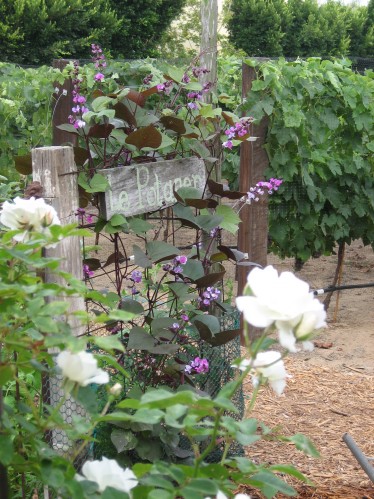 There are many different sizes and styles for a potager, or year-round kitchen garden. In fact, it is important to create a potager in your own personal style. Generally, a potager is a small plot, large enough to feed a family with daily fresh vegetables, accented by fruit and flowers.
There are many different sizes and styles for a potager, or year-round kitchen garden. In fact, it is important to create a potager in your own personal style. Generally, a potager is a small plot, large enough to feed a family with daily fresh vegetables, accented by fruit and flowers.
Choose your site wisely. A potager is a permanent year-round growing plot which is functional, as well as beautiful. As the months roll into years, you will spend a lot of rewarding time in your potager. Enhance your personal potager by where you locate it, what you grow, how you enclose it, how you adorn it, and how you manage it.
There are many wonderful elements which embody a potager such as enclosure, pathways, borders, structure, order, chaos, beauty, small trees, garden ornaments, the intertwining of function and beauty, and the romantic mixing of vegetables and flowers rotating through their seasons.
Elements That Define A Potager
1)A potager is usually defined by some type of enclosure. Enclosure can be defined as walls, fences, thick hedges. Some of these enclosures can be a working surface for your potager, for espaliered fruit trees, support for tall plantings, and heat retention. Enclosure protects from competing critters and forces such as wind.
2)Pathways are important to divide your plots, create travel pathways, and working space to care for your potager. Pathways may be made of materials such as coarse mulch, gravel, bricks, cement, or even bare soil.
3)Borders can be of a permanent design, for instance growing a low boxwood hedge, a "wood box" edge, or a stone border. Borders may also echo seasonal plantings such as a marigold border, or ornamental cabbage. Like borders will create a formal design in their repetition.
4)Structure is the bones of your potager. Structure can be vertical in the shape of an arbor, small trees, a garden ornament. Structure is also walls, gates, and even terraces. Structure adds interest, and further defines the personal style of your potager.
5)Order versus chaos. You might prefer a very formal potager, set out with boxwood borders, and neatly confined rows of planting. Your potager might start out with order, and as it grows becomes chaos, or a more romantic mixture of vegetables and flowers. Or your plantings from each seasonal beginning may by more informal, such as planting wildflower seeds.
6)Center a focal point in your potager such as a small tree, garden ornament, urn, statuary. In my potager I have planted a bay laurel tree trimmed into a two-ball topiary. A focal point might also be an impressive artichoke plant, which renews itself year and year. More examples of possible focal points are a sundial, bird bath, obelisk, or a planted arbor.
7)Place a convenient tool shed or small building where you can keep all your tools, seeds, perhaps a potting shed, and your other potager resources at hand.
Divide your potager into plots, or if you have raised beds, begin dedicating each plot or raised bed with specific seasonal vegetables you would like to grow. Remember to plant your tallest plants to the north of your potager or in the back plots of your potager.
You can start your potager with any season. Whatever season you start with plant about 2/3 of your potager, and leave 1/3 free to be planted later. For example, create a 9' x 12' plot. Divide your plots in to four rows of three plots each. Begin your potager by planting 9 of your plots, leave three of them empty. Another example, if you have 4 existing raised beds, plant 3 with seasonal vegetables, and leave 1 free to start planting when appropriate for the next season.
Eventually, your potager will slowly move into the next season, as your vegetables mature, are harvested, each plot is tilled, and replanted for the next season. Remember to keep a portion of your potager empty in anticipation of the next planting season. It will take a while to get the "ebb and flow" of it. Eventually, your potager will become fluid.
Everyone has their own timing with the four seasons and climate-specific vegetables, fruits, flowers, and herbs they can grow. Adapt your plantings to your own seasons, and your own preferences. Classic perennial favorite herbs for a potager include rosemary, thyme, oregano, marjoram, and tarragon. Other classic plantings for a potager might include strawberries, melons, annual herbs, espaliered fruit trees, and then of course, the rainbow of seasonal vegetables.
Do you have a potager now? How do you plant and manage it? What is unique about your potager?
